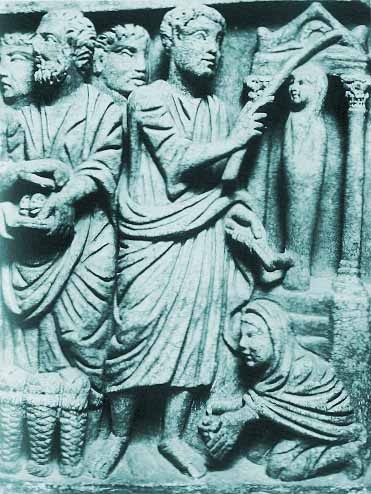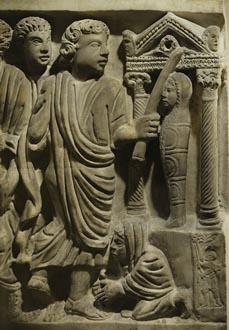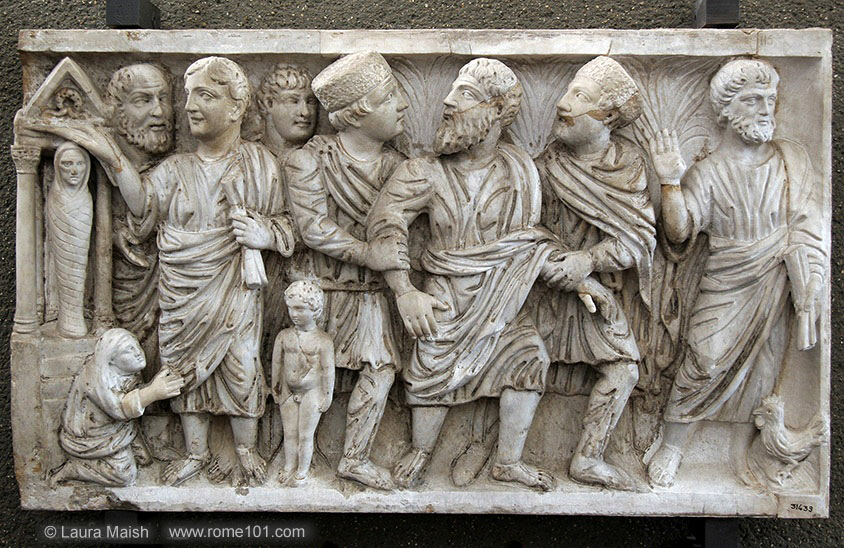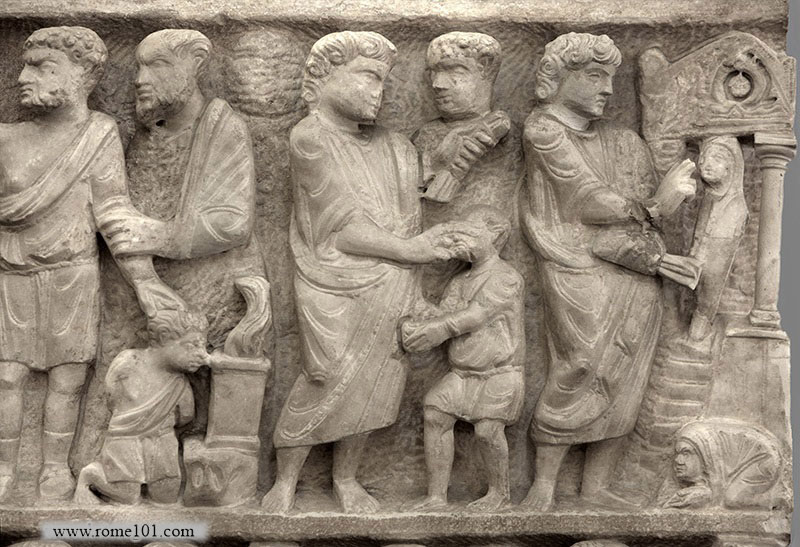
 |
Freethought & Rationalism ArchiveThe archives are read only. |
|
|
#1 | ||||
|
Veteran Member
Join Date: Aug 2004
Location: Orlando
Posts: 2,014
|
The pictures presented by LA70119 in Stephan Huller's Thread "Augustine Reports the Existence of Books on Magic Written by Jesus to Peter and Paul" got me interested in the early funerary depictions of this scene. I found an excellent website called Christ the Magician: A survey of ancient Christian sarcophagus imagery by William Storage and Laura Maish. They talk about the imagery that they have collected, some 414 total scenes, and there conclusion that Jesus was often portrayed as a magician in these 4th and 5th century images, mainly from sarcophagi. About the Lazarus scenes they have collected, they have this to say: Quote:
Here are some of the images where Mary seems to be begging Jesus for the revival of Lazarus and Jesus granting it.    In about 1/3 of the images, we just get Jesus reviving Lazarus from a Temple structure with his wand. Here are some examples of these:  Compare the Mary scenes with the text in John: 17So when Jesus came, He found that he had already been in the tomb four days. 18Now Bethany was near Jerusalem, about two miles off; 19and many of the Jews had come to Martha and Mary, to console them concerning their brother. 20Martha therefore, when she heard that Jesus was coming, went to meet Him, but Mary stayed at the house. 21Martha then said to Jesus, “Lord, if You had been here, my brother would not have died. 22“Even now I know that whatever You ask of God, God will give You.” 23Jesus said to her, “Your brother will rise again.” 24Martha said to Him, “I know that he will rise again in the resurrection on the last day.” 25Jesus said to her, “I am the resurrection and the life; he who believes in Me will live even if he dies, 26and everyone who lives and believes in Me will never die. Do you believe this?” 27She said to Him, “Yes, Lord; I have believed that You are the Christ, the Son of God, even He who comes into the world.” 28When she had said this, she went away and called Mary her sister, saying secretly, “The Teacher is here and is calling for you.” 29And when she heard it, she got up quickly and was coming to Him. Quote:
Note that the sarcophagi scenes never show the two sisters, which seems to be important if the artist wanted to depict the text in the current version of John's Gospel. In most of the images, we just have Mary throwing herself at Jesus' feet and weeping. Only in one of the images is the woman standing up and talking to Jesus.  It is interesting that this is the only image where Jesus does not carry the magician's wand. Note also that we often see Lazarus' face although the text clearly says that it was covered by a cloth. This is one more indication that the various artists were following an earlier text in representing the scene. My hypothesis that explains the single image of one woman and Jesus is that the original story only involved one woman, probably Martha. A second version of the story used the Mary character. At some point the editor of John mashed-up the two scenes. Since Luke also has a Mary and Martha scene. It seems to me a reasonable hypothesis that whoever wrote Luke, edited the John scene here too. We can conjecture that the scene in Luke was also different originally. This is how it is in our current version: Quote:
Quote:
Thoughts? Warmly, Jay Raskin |
||||
|
|
|
|
#2 |
|
Veteran Member
Join Date: Aug 2004
Location: Orlando
Posts: 2,014
|
Hi All,
Some of the images did not come out as I had planned. Here is the image of Mary or Martha standing while Jesus resurrects Lazarus. It appears to be the only one where the woman is given the dignity of not being on her knees or kissing his feet. She is merely hunched over kissing his hand. The Lazarus resurrection is portrayed in the upper left corner.  It makes me think about how many times Mary is portrayed at the feet of Jesus in the gospels. Here she is in another Lazarus Sarcaphagi image (lower right) looking more like a species of snail than a human.  Warmly, Jay Raskin |
|
|
|
|
#3 |
|
Veteran Member
Join Date: Jun 2010
Location: seattle, wa
Posts: 9,337
|
FWIW I have noticed the parallels with Secret Mark. The sarcophagi seem to often draw from apocryphal material just as the liturgies are rooted in a single, long gospel (= the diatessaron?)
|
|
|
|
|
#4 | |||
|
Veteran Member
Join Date: Aug 2004
Location: Orlando
Posts: 2,014
|
Hi stephan huller,
Quote:
One could expect a few artist to stray from the story in a few details. However, other artists should be following the text and not repeating the huge differences. Note in the story that Mary drops to Jesus' feet and cries, then Jesus goes to the tomb, and then Martha comes and persuades Jesus to raise Lazarus. Quote:
Quote:
Warmly, Jay Raskin |
|||
|
|
|
|
#5 |
|
Veteran Member
Join Date: Jun 2010
Location: seattle, wa
Posts: 9,337
|
from what I remember the wand also appears in peter images in rome
|
|
|
|
|
#6 | |||
|
Contributor
Join Date: Mar 2006
Location: Falls Creek, Oz.
Posts: 11,192
|
Quote:
I found the article to be a fascinating read. For example .... Quote:
These people have done some interesting reviews ..... Quote:
Best wishes Pete |
|||
|
|
|
|
#7 |
|
Contributor
Join Date: Mar 2006
Location: Falls Creek, Oz.
Posts: 11,192
|
|
|
|
|
|
#8 |
|
Veteran Member
Join Date: Sep 2003
Location: On the path of knowledge
Posts: 8,889
|
The evidence of these images suggest that belief in the use of a magic wand by Jesus was a very common early Christian belief and theme.
Kind of makes me wonder how common this belief is among Christians of today? Or has it just faded away? Anyone know of a church that has an 'official' teaching or position on this subject? As far as I can see the, 'wand' seems to have been somewhere along the way transformed into a 'shepherds crook'. Was this at the same time the church decided he had to grow a beard and long hair? Or were both used contemporaneously? |
|
|
|
|
#9 |
|
Veteran Member
Join Date: Nov 2011
Location: USA
Posts: 4,095
|
In the following excerpt the Catholic encyclopedia makes sweeping statements that of course have a whiff of propaganda: a) that no catacombs designs could have been from after the year 410 because of the Goth invasion; and b) that the pictures show an "early" use of all the fundamental doctrines and dogmas of orthodox Christianity.
I can only assume of course that the second assumption above necessarily relies on the first assertion, which itself must be demonstrated since if the Goths adopted the Arian version of Christianity prior to their invasion, why would that affect the creation of Christian catacomb designs in the fifth century? http://www.newadvent.org/cathen/03417b.htm Next comes the question as to how the age of an inscription can be ascertained. In the first place the inscriptions are limited to the first four centuries of the Christian Era, since, after the invasion of the Goths (410), burial in the catacombs occurred only in isolated incidences and soon ceased altogether. The later Roman inscriptions and all the inscriptions of Gaul, Africa, and the Orient, however such additional information they may give in regard to dogma, cannot here be taken into consideration. The most natural and certain method of determining the age of an inscription, i.e. through the reference it usually contains to the annual consul, can scarcely be used a dozen times in the epitaphs of the first two centuries. There are, however, many auxiliary means of determining the question, as: the names, the form of the letters, the style, the place of discovery, the pictorial emblems (varying from the anchor and the fish to the monogram of Christ); these permit, with a reasonable degree of certainty, the assignment of inscriptions to the fourth century, to the time before Constantine, to the beginning of the third or the end of the second century, or even to an earlier period. The Roman gravestones of the first four centuries furnish numerous proofs not only for the fundamental dogmas of the Catholic Church but also for a large additional number of its doctrines and usages, so that the epitaphs could be employed to illustrate and enforce nearly every page of a modern Catholic catechism. |
|
|
|
|
#10 |
|
Veteran Member
Join Date: Nov 2011
Location: USA
Posts: 4,095
|
From the tone of the article in the Catholic Encyclopedia it appears that "Christian" motifs were more numerous in engravings than in paintings or ordinary inscriptions. The Old Testament motifs appear much more common. Yet the article still seems rather resolute that all this provides evidence of orthodox Christianity before the 4th century. Yet it seems far from convincing,
|
|
|
| Thread Tools | Search this Thread |
|